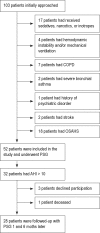Sleep disordered breathing in patients with acute coronary syndromes
- PMID: 22334805
- PMCID: PMC3266342
- DOI: 10.5664/jcsm.1652
Sleep disordered breathing in patients with acute coronary syndromes
Abstract
Study objectives: Although the prevalence of obstructive sleep apnea/hypopnea syndrome (OSAHS) is high in patients with acute coronary syndromes (ACS), there is little knowledge about the persistence of OSAHS in ACS patients after the acute event. We aimed to assess the prevalence and time course of OSAHS in patients with ACS during and after the acute cardiac event.
Methods: Fifty-two patients with first-ever ACS, underwent attended overnight polysomnography (PSG) in our sleep center on the third day after the acute event. In patients with an apnea hypopnea index (AHI) > 10/h, we performed a follow up PSG 1 and 6 months later.
Results: Twenty-eight patients (54%) had an AHI > 10/h. There was a significant decrease in AHI 1 month after the acute event (13.9 vs. 19.7, p = 0.001), confirming the diagnosis of OSAHS in 22 of 28 patients (79%). At 6-month follow-up, the AHI had decreased further (7.5 vs. 19.7, p < 0.05), and at that time only 6 of the 28 patients (21%) were diagnosed as having OSAHS. Twelve of the 16 current smokers stopped smoking after the acute event.
Conclusions: We have demonstrated a high prevalence of OSAHS in ACS patients, which did not persist 6 months later, indicating that, to some degree, OSAHS may be transient and related with the acute phase of the underlying disease or the reduction in the deleterious smoking habit.
Keywords: Acute coronary syndromes; obstructive sleep apnea hypopnea syndrome; polysomnography.
Figures
Comment in
-
Recovery of left ventricular function and sleep apnoea after acute myocardial infarction.Eur Respir J. 2013 Jul;42(1):293-4. doi: 10.1183/09031936.00000313. Eur Respir J. 2013. PMID: 23813317 No abstract available.
Similar articles
-
Behaviour and time-course of sleep disordered breathing in patients with acute coronary syndromes.Int J Clin Pract. 2005 Aug;59(8):874-80. doi: 10.1111/j.1742-1241.2005.00534.x. Int J Clin Pract. 2005. PMID: 16033605
-
Very early screening for sleep-disordered breathing in acute coronary syndrome in patients without acute heart failure.Sleep Med. 2014 Dec;15(12):1539-46. doi: 10.1016/j.sleep.2014.06.017. Epub 2014 Aug 26. Sleep Med. 2014. PMID: 25308397
-
Sleep apnea-hypopnea syndrome and acute coronary syndrome - an association not to forget.Rev Port Pneumol. 2012 Jan-Feb;18(1):22-8. doi: 10.1016/j.rppneu.2011.07.004. Epub 2011 Sep 21. Rev Port Pneumol. 2012. PMID: 21940139 English, Portuguese.
-
[Correlation of smoking and obstructive sleep apnea and hypopnea syndrome].Zhonghua Yi Xue Za Zhi. 2014 Mar 18;94(10):733-6. Zhonghua Yi Xue Za Zhi. 2014. PMID: 24844954 Chinese.
-
Prevalence of floppy eyelid syndrome in obstructive sleep apnea-hypopnea syndrome.Ophthalmology. 2006 Sep;113(9):1669-74. doi: 10.1016/j.ophtha.2006.02.053. Epub 2006 Jul 7. Ophthalmology. 2006. PMID: 16828509
Cited by
-
Sleep Apnea Evolution and Left Ventricular Recovery After Percutaneous Coronary Intervention for Myocardial Infarction.J Clin Sleep Med. 2018 Oct 15;14(10):1773-1781. doi: 10.5664/jcsm.7394. J Clin Sleep Med. 2018. PMID: 30353816 Free PMC article.
-
Sleep Disturbance after Hospitalization and Critical Illness: A Systematic Review.Ann Am Thorac Soc. 2017 Sep;14(9):1457-1468. doi: 10.1513/AnnalsATS.201702-148SR. Ann Am Thorac Soc. 2017. PMID: 28644698 Free PMC article.
-
Predictors of long-term adherence to continuous positive airway pressure in patients with obstructive sleep apnoea and acute coronary syndrome.J Thorac Dis. 2018 Jan;10(Suppl 1):S124-S134. doi: 10.21037/jtd.2017.12.128. J Thorac Dis. 2018. PMID: 29445536 Free PMC article.
-
Timely diagnosis and treatment of sleep apnea reduce cardiovascular sequelae in patients with myocardial infarction.PLoS One. 2018 Jul 30;13(7):e0201493. doi: 10.1371/journal.pone.0201493. eCollection 2018. PLoS One. 2018. PMID: 30059554 Free PMC article.
-
Prevalence and predictors of sleep apnea in patients with stable coronary artery disease: a cross-sectional study.Ther Clin Risk Manag. 2017 Aug 18;13:1031-1042. doi: 10.2147/TCRM.S136651. eCollection 2017. Ther Clin Risk Manag. 2017. PMID: 28860787 Free PMC article.
References
-
- Peppard PE, Young T, Palta M, Skatrud J. Prospective study of the association between sleep-disordered breathing and hypertension. N Engl J Med. 2000;342:1378–84. - PubMed
-
- Young T, Peppard P, Palta M, et al. Population-based study of sleep-disordered breathing as a risk factor for hypertension. Arch Intern Med. 1997;157:1746–52. - PubMed
-
- Peker Y, Carlson J, Hedner J. Increased incidence of coronary artery disease in sleep apnoea: a long-term follow-up. Eur Respir J. 2006;28:596–602. - PubMed
-
- Gami AS, Pressman G, Caples SM, et al. Association of atrial fibrillation and obstructive sleep apnea. Circulation. 2004;110:364–7. - PubMed
-
- Kanagala R, Murali NS, Friedman PA, et al. Obstructive sleep apnea and the recurrence of atrial fibrillation. Circulation. 2003;107:2589–94. - PubMed
MeSH terms
LinkOut - more resources
Full Text Sources
Medical



